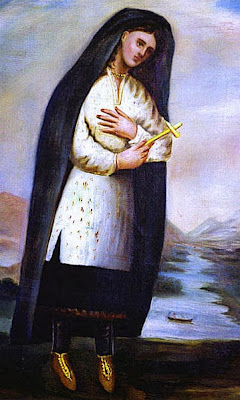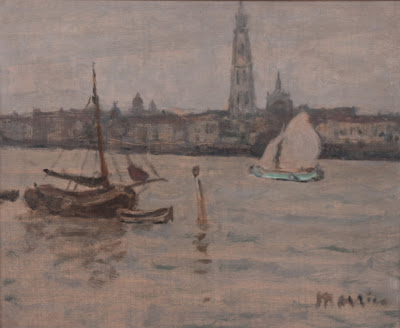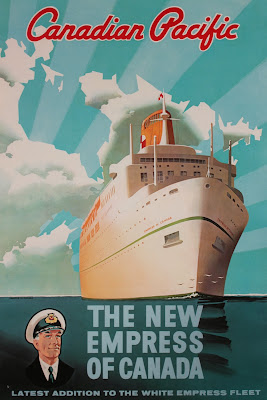'TWAS IN THE MOON OF WINTERTIME: THE ARTS IN NEW FRANCE
‘Tis the season to be jolly, once again. In proper yuletide spirit the gallery has been playing Christmas music this December. I personally enjoy many festive holiday songs and hymns, but tend to gravitate towards traditional ones such as Personent Hodie or O Come, O Come Emmanuel. One of my long-standing favourites in this category is The Huron Carol (also known as ‘Twas in the Moon of Wintertime}.
The Huron Carol is Canadian, and is widely assumed to be the country’s first Christmas carol. The anglicized version of the Huron Carol as we know it today was written in 1926 by Jesse Edgar Middleton. However, the carol is very old; as old as some of the earliest colonization. It was written circa 1640, and was composed by Father Jean de Brebeuf (1593-1649) to the tune of a traditional French folk song called Une Jeune Pucelle.
Father Jean de Brebeuf was a French Jesuit missionary originally from Normandy. His first colonial tour posted amongst the Huron people was between 1625-1629. After a few years back in France he returned as a missionary to the Ste-Marie-Amongst-the Hurons settlement from 1639-1649 (near present day Midland, Ontario). de Brebeuf was well acknowledged for his tenacity at acquiring fluency in the Iroquoian-language of the Huron and his ability to immerse himself in their culture. de Brebeuf’s command of the Huron language was beneficial for the missionaries cause, as they aimed to use familiarity to better connect with those whom they were preaching to. This reminds me of how Italian painters of the middle ages and renaissance would depict the nativity (or any religious scene) in contemporary Italian settings. Certainly the Christ child was not born amongst 15th century Florentines, yet the message seemed clear nonetheless. It is within this context that the Huron Carol was composed.
Original Lyrics
Ehstehn yayau deh tsaun we yisus ahattonnia O na wateh wado:kwi nonnwa 'ndasqua entai ehnau sherskwa trivota nonnwa 'ndi yaun rashata Iesus Ahattonnia, Ahattonnia, Iesus Ahattonnia
Ayoki onki hm-ashe eran yayeh raunnaun yauntaun kanntatya hm-deh 'ndyaun sehnsatoa ronnyaun Waria hnawakweh tond Yosehf sataunn haronnyaun Iesus Ahattonnia, Ahattonnia, Iesus Ahattonnia
Asheh kaunnta horraskwa deh ha tirri gwames Tishyaun ayau ha'ndeh ta aun hwa ashya a ha trreh aundata:kwa Tishyaun yayaun yaun n-dehta Iesus Ahattonnia, Ahattonnia, Iesus Ahattonnia
Dau yishyeh sta atyaun errdautau 'ndi Yisus avwa tateh dn-deh Tishyaun stanshi teya wennyau aha yaunna torrehntehn yataun katsyaun skehnn Iesus Ahattonnia, Ahattonnia, Iesus Ahattonnia
Eyeh kwata tehnaunnte aheh kwashyehn ayehn kiyeh kwanaun aukwayaun dehtsaun we 'ndeh adeh tarrya diskwann aunkwe yishyehr eya ke naun sta Iesus Ahattonnia, Ahattonnia, Iesus Ahattonnia
English translation of original:
Have courage, you who are human beings: Jesus, he is born The okie spirit who enslaved us has fled Don't listen to him for he corrupts the spirits of our thoughts Jesus, he is born
The okie spirits who live in the sky are coming with a message They're coming to say, "Rejoice! Mary has given birth. Rejoice!" Jesus, he is born
Three men of great authority have left for the place of his birth Tiscient, the star appearing over the horizon leads them there That star will walk first on the bath to guide them Jesus, he is born
The star stopped not far from where Jesus was born Having found the place it said, "Come this way" Jesus, he is born
As they entered and saw Jesus they praised his name They oiled his scalp many times, anointing his head with the oil of the sunflower Jesus, he is born
They say, "Let us place his name in a position of honour Let us act reverently towards him for he comes to show us mercy It is the will of the spirits that you love us, Jesus, and we wish that we may be adopted into your family Jesus, he is born
Although de Brebeuf is remembered as the author of The Huron Carol, Iesus Ahatonnia, he is even more renowned for his martyrdom. The Iroquois Confederacy vanquished the Ste-Marie settlement in 1649, and de Brebeuf and other Jesuit missionaries were ritually subjected to torture and killed. Despite the horrific martyrdoms at Ste-Marie-amongst-the-Hurons French clergymen fervently continued to set up missionaries in New France in the 17th century. The arts: music, literature, and fine art, remained an important tool in the preaching agendas of missionaries. Thus like the Huron Carol, Canada’s very earliest fine art was produced almost exclusively by French clerical missionaries.
It is not until centuries after the Jesuits arrived in New France that we begin to see certain artists and their artwork as possessing a true Canadienness. This occurs with the artists Paul Kane and Cornelius Krieghoff at around the time of Confederation in the mid 19th century. Yet when I reminisced about the history of the Huron Carol this December, I decided it might be a good excuse to peruse some of the country’s very earliest fine art from that same period in our history.
Most of the surviving works of art from 17th century New France date to a few decades after the Huron Carol was composed. It has been cited that one Abbe Pommier was likely to have been the very first to officially paint on French colonial soil. Hilariously, he is often quite bluntly described as having been a terrible painter. Unfortunately I was not able to find any firmly attributed examples of his work to confirm his abilities. A portrait, La Mere Marie-Catherine de Saint-Augustin, is attributed to Pommier from 1668 with later over painting. Three more of the earliest known French clerics who painted in the colonies were Fathers Jean Pierron (1631-1700), Louis Nicolas (1634- c. 1701) and Claude Chauchetiere (1645-1709). There is scant tangible work remaining by these clerical painters but one well-known work by Chauchetiere is the Portrait of Saint Kateri Tekakwitha from circa 1696. It has a naïve quality not unlike contemporaneous French provincial paintings, as do most of the surviving works from that time. One of the few non-religious examples to survive by one of these clerics is the Codex Canadensis written and illustrated by Father Louis Nicolas between 1674-1680. It contains watercolours of his interpretation of the land and its people. The book is at the Thomas Gilcrease Museum in Tulsa, Oklahoma, and their online collection records provide a glimpse of the book with a page depicting natives fishing in a river, called La Pesche des Sauvages.
Perhaps the most prominent and capable painter of this period who travelled to New France was Frere Luc, born Claude Francois. He was already a painter of some talent prior to entering the clergy in 1644 back in France. He had worked in studios alongside some of the great French classicists of the period, including Nicolas Poussin and Claude Lorrain. He learned by copying works of art by Italian masters of the previous generations, such as the High Renaissance artist Raphael and Baroque artist Guido Reni. Frere Luc came to New France in 1670 to assist in re-establishing an abandoned monastery belonging to the Recollet Order. Despite only being in New France for 15 months, he left a far larger oeuvre and lasting impression than any other clerical artists. A Recollet cleric, Father LeClercq, notes decades later in a correspondence from 1691 that:
This good religious {Frere Luc} laboured for fifteen months on many works, which he has left as so many marks of his zeal: the painting over the high altar of our Church and that of the chapel; he enriched the parish Church {Notre-Dame-de-Quebec} with a large painting of the Holy Family, that of the Reverend Jesuit Fathers with an Assumption of the Blessed Virgin; and he completed that of the high altar representing the Adoration of the Wise Men. The churches at Ange Gardien, Chateau-Richer, the Cote de Beaupre, at Sainte-Famille on the Ile d’Orleans and of the Hospital {Hotel-Dieu, Quebec} Were also indebted to his work…..
Unfortunately most of the above-described paintings are probably lost for good, but some of Frere Luc’s work endures. The most famous of these works is a Baroque style Assumption of the Virgin in the Hopital-General de Quebec. Another surviving painting by Frere Luc is convenient for this blog topic; being that it includes both Huron and somewhat Christmas-related themes. It is La Sainte Famille a la Huronne, and depicts the Holy Family with St. Joseph presenting a small Huron girl to the Virgin and infant Jesus. The little Huron girl is wearing a medal of a type given to converts by missionaries at the time. Even more convenient to this blog topic is that Frere Luc painted an Adoration of the Magi scene while in New France (as mentioned by LeClercq. The Adoration theme is integral in the original lyrics of The Huron Carol. The New France Adoration is probably lost, so instead I have provided visual references of the Adoration of the Magi by Frere Luc’s French colleague Nicolas Poussin, and another by the Italian Baroque master Guido Reni whom he often copied.
Perhaps the most recognized 17th century painting from New France is La France Apportant la foi aux Hurons de la Nouvelle-France. This oil on canvas is currently housed in the Musee des Ursulines, Quebec. The painter is unknown, but is often attributed to Frere Luc and dated circa 1670. The painting is set alongside the shores of the St. Lawrence River and depicts France symbolically personified in the form of Anne of Austria (mother and regent on then young King Louis XIV) teaching a kneeling Huron man about Christianity and faith through the use of a painting of the Virgin Enthroned and by pointing to the heavens above. In the background on the river is a ship that prominently displays the coat-of-arms of a Breton nobleman. This painting perfectly sums up the primary intentions and prevailing attitudes of clerical occupation in New France during the 17th century. The importance of immersing the native people of North America in the Christian faith was paramount. This is overtly evident both in La France Apportant la foi aux Hurons de la Nouvelle-France, as well as in the original lyrics of The Huron Carol.

Happy Holidays from Masters Gallery.
BY: JILL TURNER
PHOTO CREDITS:
1., 2. and 3. Images of Huron Carol themed Christmas stamps issued Christmas 1977 by Canada Post
4. Gentile de Fabriano. Adoration of the Magi. Italian, circa 1423 in the Uffizi Gallery, Florence
5. Detail of a Cornelius Krieghoff Habitants oil on panel Sold at Masters Gallery Vancouver, 2013.
6. Attributed to Abbe H. Pommier. La Mere Marie-Catherine de Saint-Augustin. (1668) in the Monastere des Augustines de l'Hotel-Dieu du Quebec
7. Claude Chaucheterie. Portrait of Saint Kateri Tekakwitha circa in the Caughnawaga Museum
8. Louis Nicolas. La Pesche des Sauvages in the Codex Canadensis. 1674-1680 in the Thomas Gilcreast Museum
9. Frere Luc. Assumption of the Virgin circa 1670 in the Hopital-General de Quebec Eglise Notre Dame des Anges
10. Frere Luc. La Sainte Famille a la Huronne circa 1670 at the Monastere des Ursulines, Quebec City
11. Nicolas Poussin. Adoration of the Magi 1633 in the Gemäldegalerie, Dresden, Germany
12. Guido Reni. Adoration of the Shepherds circa 1640 in the National Gallery, London, UK
13. La France Apportant la Foi aux Hurons de la Nouvelle-France circa 1670 (attributed to Frere Luc often) in the Musee des Ursulines, Quebec





_.jpg)










































